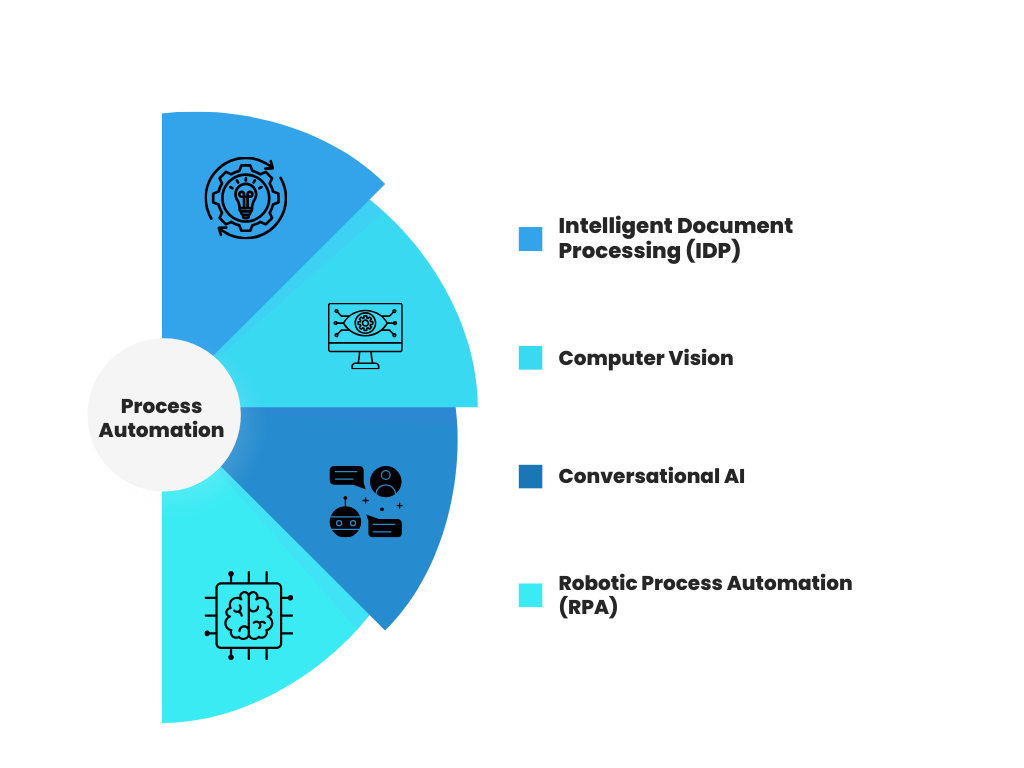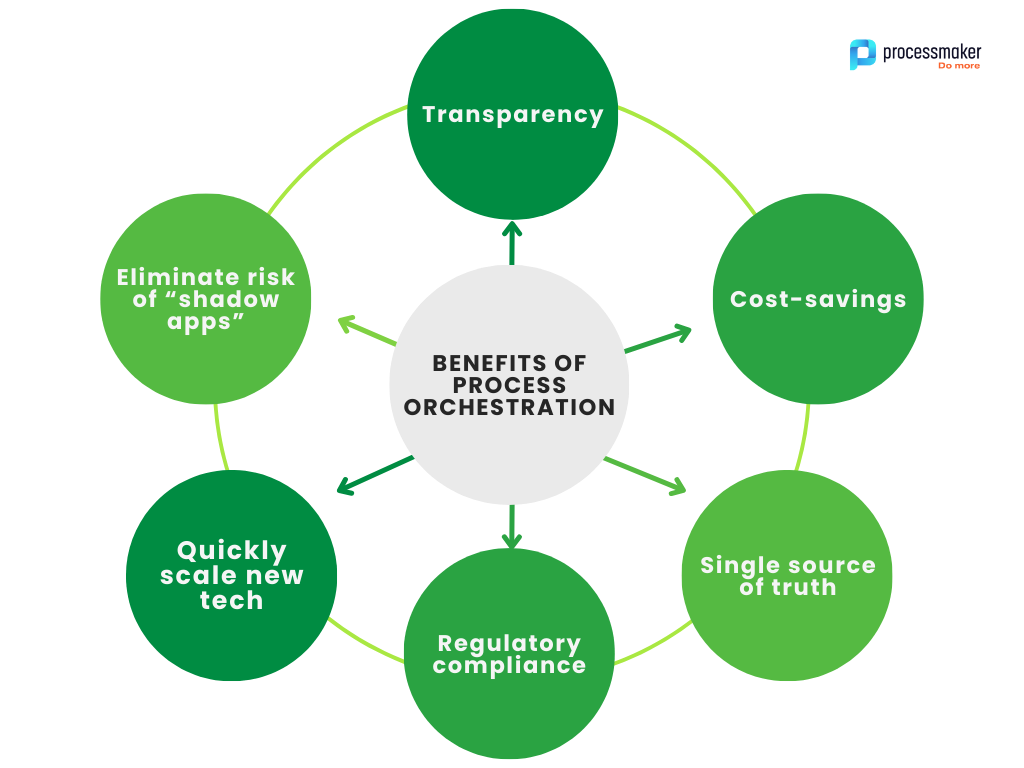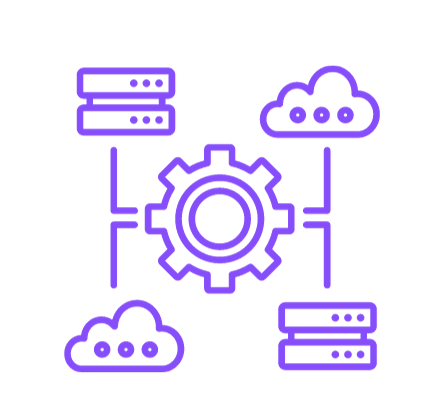Hyperautomation has intensified the automation race, with 66% of companies automating at least one critical process. But to truly achieve end-to-end automation, there’s a secret ingredient top performers know they can’t ignore. It’s vital to handling sophisticated, complex, and layered processes that Gartner rates it amongst its top innovation drivers. Process orchestration is a must-have to reach your most aggressive automation goals.
What is process automation?
There are many ways to execute a process. Your strategy can be hands-on, with you and your team performing a handful of manual tasks. You could integrate technology, like a squadron of Robotic Process Automation (RPA) bots, to help with data entry.
Intelligent automation is just one of the ways to get the job done. You can automate a series of tasks in a business process manager (BPM) or use a single-purpose application to perform simple tasks like:
- Scheduling Instagram or Twitter content for auto-post
- Routing emails containing a set of keywords into their own folder
- Sending a notification to a manager once a project is marked complete
- Your laundry machine texts you to say the wash is done
Process automation doesn’t specify a specific type of automation—the sky’s the limit. But it does focus specifically on tasks performed through automation, not those humans fulfill manually.
What are the different types of automation?
There’s a Mary Poppins-level of options when reaching into your automation bag. Here are a few of the most popular automation technologies.

Intelligent Document Processing (IDP)
Documents come through your systems via upload, scan, email—or other methods—and intelligent document processing (IDP) gets to work extracting and organizing content.
Other tasks, like report generation or form population, usher data, such as customer names or phone numbers.
Computer Vision
Machines can “see” text and images and make decisions based on their content.
An example of computer vision is a bank’s AI-powered Know-Your-Customer checks. Take a photo of a driver’s license and snap a real-time selfie, then computer vision takes the wheel. This tech can determine whether an ID matches the person on the screen—and whether that person is real.
Conversational AI
Trigger automations through ChatGPT-style conversation. Supercharged chatbots can walk users through complex processes like applying for college or opening a bank account.
Dialog triggers automated tasks under the hood, satisfying the customer’s real-time requests.
Robotic Process Automation (RPA)
Machine-learning algorithms hop in to perform administrative legwork. RPA bots can do simple tasks, like plopping a customer’s first name into an email greeting. Their skills go all the way up to complex heavy lifting, like hunting through data to find potential compliance issues.
What is process orchestration?
Eventually, things get a little more complex. Your process puzzle breaks into more pieces. Consider a self-service banking portal or an aerospace company reordering key components.
These processes have more than one automation and have several objectives. They each contain a cascade list of tasks that weave through multiple departments.
Consider these three scenarios where success relies on several interconnected processes:
- A bank collects information from a new loan applicant. The tool cuts the phase in half, but the bank still uses old manual KYC checks on the back end. The customer waits three days for approval—but by then, they’ve moved on to a more responsive competitor.
- Mason purchases a new phone case from an online retailer. However, the website needs to sync with real-time inventory. Nor is the inventory system linked with a CRM that can inform Mason the product is out of stock. He only realizes the problem when he arrives to pick up his order—and now he’s frustrated.
- Paula, a salesperson in the aerospace industry, receives a request from a new client. Enthusiastic, she sends the sample order of RF connectors out right away. With few automated safeguards, the order leaves the warehouse without accounting’s knowledge. The invoice falls behind, impeding Paula’s ability to conduct further business with the hot lead.
The problem? Disconnected actions that miss the mark on the Holy Grail of digital transformation: end-to-end automation.
Enter: process orchestration, a strategy experts predict will explode by $18.5 billion come 2030. Process orchestration achieves end-to-end automation by bringing all your apps, AI tools, bots, personnel, and legacy software to play together like an orchestra.
How does process orchestration boost Hyper-Productivity?
Process orchestration can be a game-changer for your organization in more ways than one. One of the most significant ways you can transform your workflow is by boosting Hyper-Productivity. Instead of simply being productive, your team can become Hyper-Productive, completing work faster and more efficiently than ever.
Benefits of process orchestration:

- Transparency: A real-time view into all processes moving through your organization
- Cost-savings: Identify redundant tasks or spotlight areas for additional automation
- A single source of truth: Instead of having a CRM, invoicing system, and a marketing email provider access their separate copy of customer emails, you can funnel all processes through one centralized location.
- Regulatory compliance: When process monitoring efforts exist in one place, it’s far easier to manage audits.
- Quickly scale new technologies: Drop the latest tech into one process manager instead of installing and executing it in multiple instances.
- Eliminate the risk of “shadow apps”: Departments deploying single-purpose apps can damage information security efforts and make things unmanageable for IT. You can better supervise operations by routing your tech stack through one process manager governed by process orchestration.
Without process orchestration, it’s like you’re hearing two notes of an hour-long symphony and asked to guess how the rest of the show went. Process orchestration puts you on the conductor’s podium for the entire performance. You can adjust when necessary and have a comprehensive, end-to-end view of the whole show.
How do process orchestration and automation work together?
In the early days of automation, organizations searched for tools and technologies to automate as many use cases as possible.
But there wasn’t a captain of the ship.
Sales automated essential tasks using one platform, while marketing or purchasing opted for their toolkit. Software rarely worked together. Apps ran independently of one another, with no insight into what the others were doing. Processes were challenging to monitor, track, and manage.
You can view the synergy through the lens of a painfully modern problem that plagues nearly every household: picking a movie to watch together.

Entertainment providers split off from mega-streamers like Hulu to serve their content through proprietary apps. For the average American, that means 100,000 hours of movies and TV shows—11 years’ worth of content to pick from on a Friday night.
Instead of praising the selection, sentiments are drifting the opposite way: viewers don’t want to bounce between 3 and 4 apps to find something to watch. They miss the cable days of yore, where a one-stop-shop guide consolidated everything into one list.
You can think of process orchestration as the enterprise equivalent of too many streaming apps—too many point solutions or single/limited-purpose applications running isolated from each other, without a guide managing it all.
Process orchestration puts you at the helm. It’s a digital ringleader that provides instant visibility into automated or manual processes and allows you to make changes. Identify redundant steps, pinpoint obstacles, and tweak task sequences or actions. You couldn’t do things without orchestration, uniting all your processes under one umbrella.
Process orchestration vs. process automation: Which one is best for me?
Micro-companies that only require a handful of single-use automations—like an appointment or social posting scheduler—probably will not need process orchestration.
But once you start employing more complex technologies with sophisticated decision points—it’s time for a fresh strategy.

Process orchestration is ideal for companies that:
- Run processes that spill over into several departments (and across regions!)
- Collect information from multiple systems
- Rely on several technologies to deliver customer promises
- Use processes with expansive conditional logic
- Require several layers of managerial approval
- Are in a highly regulated industry where a change in government policy can upend several vital processes
Industries like healthcare, finance, and higher education—any space running complex, layered processes—should select a BPM that values process orchestration.
See how this insurance provider used process orchestration to turn 100,000+ basic form submissions into a fully automated workflow
The Redwoods Group took command of their incident report processes using a process orchestration mindset.
Previously, counselors submitted reports through a Google-like Form, which is great for collecting information—but not so much for acting on it. You had to send email attachments separately, which gave the group little view into which reports were still pending resolution.
With ProcessMaker, The Redwoods Group was able to turn their basic online form into a full-fledged automated workflow. Every task became a cog in the greater machine. They could track reports, see whose office still needed to review them, and collect all materials—text, images, and video—in a single available-at-a-click record.
Future trends in process orchestration
Everything that fuels today’s business points to a growing process sophistication, from the amount of data to the number of customer interactions.
The Internet of Things tags an army of sensors on physical goods like fitness mirrors and coffee machines. Businesses will have more data to contend with than ever before, underscoring the need for well-organized processes.
APIs give and take more data than ever before. Organizations must closely monitor the process’s flow, from complex banking-as-a-service plays to integrations with large language models.
Organizations can adopt the trends driving future growth with well-oiled, highly orchestrated processes. It’s a must-have for any business involved in intelligent automation—is your process orchestration strategy ready?
Chat with our team to find the best business process automation software for you.






